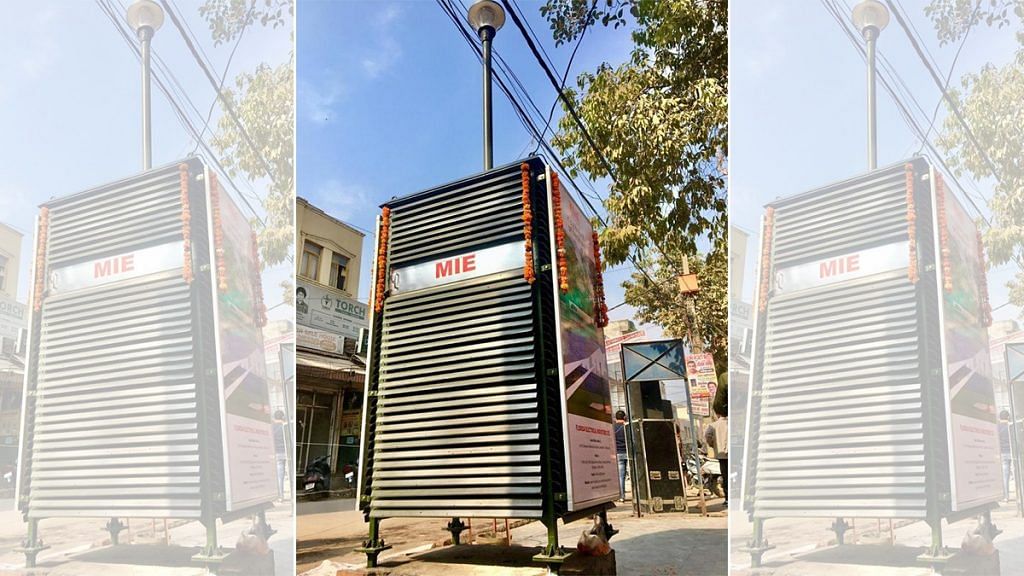New Delhi: Bharatiya Janata Party (BJP) MP Gautam Gambhir installed a giant air purifier in the Krishna Nagar market area of his East Delhi constituency, the third such purifier he set up to tackle air pollution in the city.
The first two of these air purifiers were installed in Lajpat Nagar and Gandhi Nagar markets.
At the latest inauguration, held Sunday, Gambhir reportedly said, “This purifier may not solve the problem of pollution completely but as someone born and brought up in this city, I cannot just sit at home and let things worsen.”
The smog tower at Lajpat Market had been procured by Gautam Gambhir Foundation and installed with the help of Lajpat Nagar Traders Association. The purifiers installed at Gandhi Nagar and Krishna Nagar markets that tower at 12 feet and cover an area of 100 square metres have been produced by a Delhi-based company called Florida Electrical Industries Ltd. Gambhir procured these two as well.
Florida Electrical’s director Rachit Arora said the purifier can clean two lakh cubic metres of air within 11 hours.
“The company believes that the pollution problem is at its worst ever and we are at a crossroads. That makes outdoor air purification a need of the hour and a solution we may not like or choose, but have to at least explore as a first aid and foundation stone,” Arora said.
However, experts told ThePrint that such outdoor air purifiers are red herrings at best and air pollution should be curbed at the source. According to them, air purification at this scale is unscientific.
ThePrint reached Gambhir via calls and texts for a comment but there was no response until the time of publishing this report.
Also read: The secret origins of China’s 40-year plan to end carbon emissions
How the air purifiers work
The giant air purifiers operate on a “multi-step filtration model” that is capable of “reducing smoke, dust, particulate pollution”, according to Arora. The purifiers use about 100 filters. Arora was, however, reluctant to share the details of the design citing patent concerns.
“It also acts against bacteria, viruses as well. After a few hours of operations, a 30-40 per cent reduction in PM 2.5 levels are observed,” he said.
The machines rolled out in September cost anywhere around Rs 6.5-Rs 7 lakh. More economical models are available for industries, hospitals, schools and malls.
The initial stages of the project involved “third party surveying and data analysis”. “In the last one year, extensive testing and R&D (Research and Development) was done. But the launch was delayed due to lockdown and the Covid-19 outbreak,” he said.
Arora added that the model installed in east Delhi consumed 10-12 units of electricity per day, amounting to 300-350 units per month.
For now, the company is in discussion with Gurugram Metropolitan Development Authority (GMDA) for its next launch. Last month, the Delhi government had also installed anti-smog towers, i.e. large-scale air purifiers, in order to reduce pollution.
Back in November 2019, the Supreme Court had asked the Centre and the Delhi government to come up with a roadmap for the installing of smog towers in the national capital.
Also read: Delhi govt sprinkles 70 lakh litres of water at 13 pollution hotspots to control dust
What experts say
While advocated by the government, outdoor filtration systems have been a cause for concern for many experts within the scientific community.
In their paper Can We Vacuum Our Air Pollution Problem Using Smog Towers?, researchers Sarath Guttikunda and Puja Jawahar of Urban Emissions, an independent research group on air pollution, had argued, “With no boundaries (in the atmospheric conditions), it is unscientific to assume that one can trap air, clean it, and release into the same atmosphere simultaneously. Expecting filtering units to provide any noticeable results at the community level is unrealistic.”
Noting this point, Anumita Roy Chowdhury, executive director, Centre for Science and Environment, said, “Air purification works when you are in confined environment with trapped air… But in outdoor conditions when a situation is so dynamic, wind is constantly blowing, the volume of air we are talking about is extraordinary. You just can’t think of cleaning that up.”
She added that there haven’t been any instances outside of India where outdoor air purification has been adopted as a regulatory action to mitigate air pollution.
Jyoti Pande Lavakare, co-founder of Care for Air India, a non-profit advocacy group, said, “Any air purifier or a smog tower, they use physical filters … These filters (after being clogged) will then be tossed in the landfills that are already overflowing. So instead of cleaning the air it will further add to the pollution.”
Additionally, she pointed out that according to a few estimates, thousands or even lakhs of purifiers have to be set up to effectively deal with air pollution.
“You will need them hyperlocally, even in a residential space, but where is the space, electricity and who’s going to pay for it,” she said, adding that only manufacturers stand to benefit from this.
Last month, Care for Air India had filed a public interest litigation (PIL) with the Supreme Court asking to stay its earlier direction to install these outdoor purifiers at public cost. The petition was dismissed.
Dr Ravindra Khaiwal, professor of environment health at PGIMER Chandigarh, emphasised that “prevention is the best policy”. “We would appreciate source control… These are faith building exercises but will not be useful to controlling the source,” he said.
“It is similar to asking people to make use of RO (water purifiers) or indoor air purifiers but you have to understand that if we have high concentration of pollutants, it becomes an expensive affair (to purify it),” added Khaiwal.
Also read: Pusa tablets — the microbial cocktail that gives farmers an alternative to stubble burning
